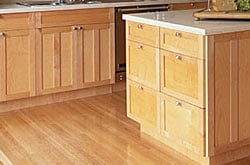Going Green with Stone Slab Countertops
See if We Have Top-Rated
Green Professionals in Your Area

Not surprisingly, stone slab is a naturally green countertop material. It's moisture resistant, lasts a lifetime, is very sanitary, and releases almost no harmful byproducts into your indoor air. In other words, you're already going green by choosing a solid slab countertop in the first place. There are steps you can take to make your stone slab countertops even greener, however. Here's what you need to know about stone slab countertops if going green is on your radar.
Going Green with David Johnston
First of all, HomeAdvisor understands that it can be tough for homeowners to wade through all the "green" remodeling information out there, which is why we've teamed up with green remodeling expert David Johnston to provide you with the best, most accurate, green remodeling advice in the business. David Johnston is the founder of the green consulting firm What's Working, Inc., the author of multiple books on green remodeling (including the Nautilus Award winner Green Remodeling: Changing the World One Room at a Time), and he's an expert on green countertop projects and working with natural stone. Here's a green guide to installing stone slab countertops in your home, drawn from the experience, wisdom, and writings of Mr. Johnston himself.
Green Remodeling 101: Calculating Value
For starters, let's talk cost. Budget is a big concern on any remodeling project, and the high cost of stone can make some homeowners balk at the prospect of spending even more by going green. However, the truth of the matter is that going green with stone slabs rarely costs more than a conventional project, and in many cases, it can actually end up saving you money. In addition, Johnston is quick to point out that the true value of green remodeling is hard to put a price tag on. Things like low maintenance requirements, which equals more time for homeowners, higher quality work, longer lasting materials, and healthier homes are far more valuable than any budget can reflect. Add to that the peace of mind that comes in knowing you've made a commitment to a better, more sustainable world for your kids and grandkids, and the real value of going green starts coming into focus.
How to Green Your Countertop Project the David Johnston Way
So what can you do to make sure your new stone slab installation is as green as they come? David Johnston has several suggestions, ranging from where you obtain your stone to how you manage your job site and waste materials, which will help you achieve the greenest stone slab countertop possible.
Which Shade of Green is Right for You?
While thinking green when it comes to stone slab countertops is a smart choice for your pocketbook, your health, and the environment, it's not unusual for homeowners to feel a little overwhelmed when presented with the full scope of green remodeling options. If you're feeling unsure about how green you're willing to go with your stone slab countertops, there's no need to worry — going green isn't an all-or-nothing proposition. Any step you take in a green direction is a smart one, whether you search a local stone provider, use recycled materials like remnant stone or reclaimed stone tile instead of purchasing a brand new slab, or green your countertops from top to bottom.
If you do think green is the right choice for your stone slab countertops, talk with your contractor about adopting a green remodeling philosophy, find a contractor who specializes in green building and remodeling, or seek out the services of a green consulting firm so that you can be sure your new stone countertop ends up being as green as they come.

